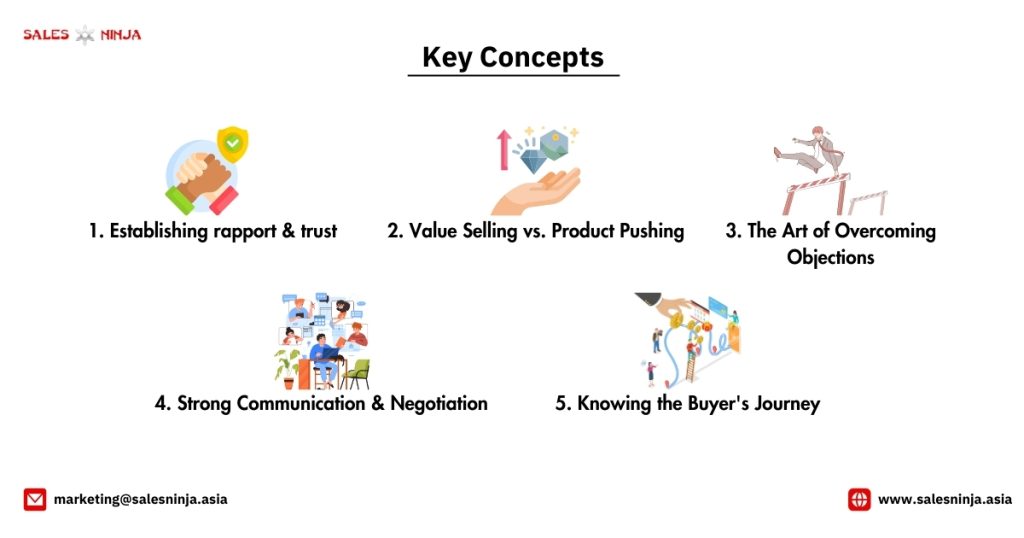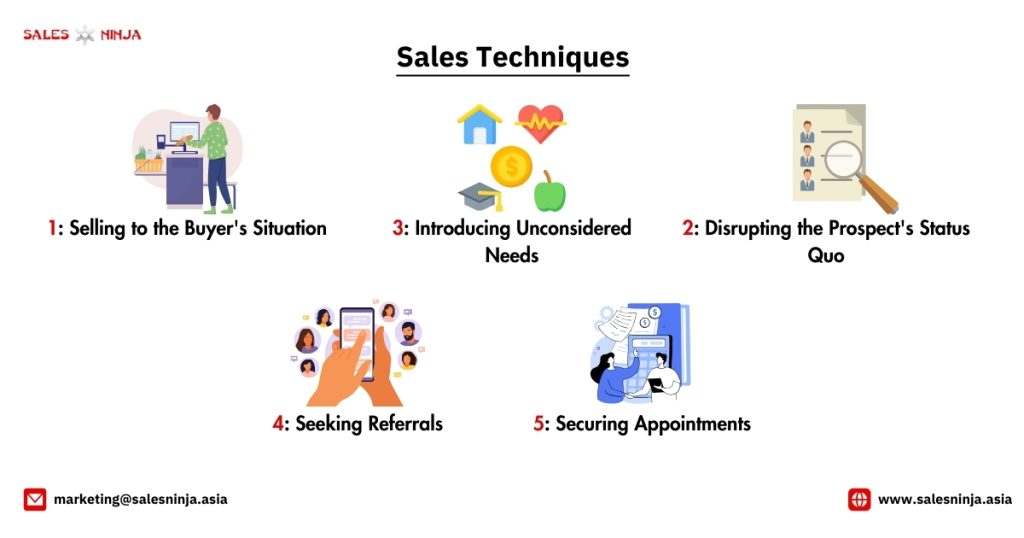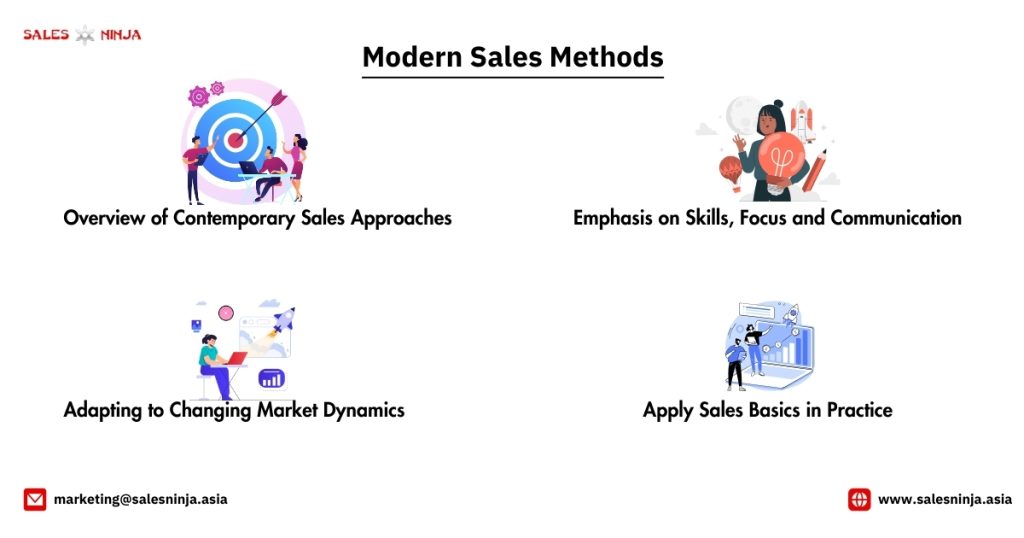Sales is a fundamental aspect of any business. Whether you are selling products, services, or ideas, the success of your organization heavily relies on its sales performance. So having a solid understanding of the foundations of sales is crucial for achieving and maintaining success.
Many people tend to have misconceptions about what sales entails. Some may think that it simply involves convincing someone to buy something they don’t need or want. However, in reality, sales are much more than that.
According to Wikipedia, “Sales refers to activities related to selling or the number of goods sold in a given targeted time period.” This definition highlights two key elements:
- It includes all forms of selling – whether it be face-to-face interactions with customers or online transactions; and
- It focuses on results – specifically the number of goods sold within a specific timeframe.
Now that we have a clear concept of what sales are, let’s try to delve even deeper into why understanding the foundations of sales is essential for anyone involved in the business.
Importance Of Understanding Foundations of Sales
Firstly, knowing the basics allows individuals to develop their skills and expertise in this field. Like any other profession or discipline, mastering the fundamentals sets one up for long-term success and growth potential.
Moreover, understanding how different aspects such as customer psychology and communication techniques play a role in successful sales can give businesses an edge over their competitors. Additionally, being equipped with knowledge about consumer behavior trends can also help companies anticipate changes in demand and adapt accordingly.
Key Concepts
The foundations of sales are the fundamental principles and concepts that form the basis for successful selling. These key concepts serve as a framework for understanding the sales process, building relationships with customers, and achieving desired outcomes.
These essential ideas can be summarized into several categories; let’s examine them.
-
Establishing rapport and trust
Developing relationships with potential consumers is fundamental to the sales process. Building rapport and trust is essential to this. You may establish true connections with clients by understanding their requirements and connecting with them on a human level when you have a solid basis. Effective communication, empathy, and active listening are all critical skills in this process.
-
Value Selling vs. Product Pushing
Effective salespeople avoid simply “pushing” products. They emphasize value-based marketing. This strategy entails figuring out the problems and obstacles that the client faces. Subsequently, you exhibit how your offering tackles these issues, providing tangible benefits that elevate their enterprise or existence. You may establish a situation where everyone wins by concentrating on the advantages and results.
-
The Art of Overcoming Objections
There are always challenges in sales interactions. Developing your ability to handle objections well will enable you to anticipate issues before they arise, negotiate difficulties amicably, and eventually turn rejections into chances to seal the transaction. Clarifying demands, offering alternate solutions, and actively listening are just a few of the powerful objection-handling techniques that come with having a solid sales foundation.
-
Strong Communication and Negotiation
A great sales encounter is built on effective communication. It is imperative to possess the ability to articulate your value offer in a clear, succinct, and convincing manner. Likewise, proficient negotiating abilities enable you to reach win-win compromises that satisfy both sides. These communication and negotiating abilities may be developed using the framework that sales principles give, enabling you to confidently handle conversations and engagingly present your offering.
-
Knowing the Buyer’s Journey
Before speaking with salespeople, today’s consumers do a lot of research online. Knowing these several phases—from awareness and contemplation to decision-making and post-purchase assistance—allows you to adjust your strategy appropriately. You may engage with buyers at the appropriate touchpoints and smoothly assist them in making a purchase choice if your sales approach is in line with their journey.
All these key concepts work together synergistically within the framework of ethical conduct to form strong foundations upon which successful selling techniques are built. Understanding the foundations of sales and implementing these key concepts is essential for any sales professional looking to excel in their field and create long-term success.
Understanding the Sales Process
The sales process refers to the systematic sequence of steps a salesperson takes to convert a potential customer or lead, into a paying customer. It’s a dynamic and adaptable framework, allowing for adjustments based on specific industries and sales methodologies. However, a core set of stages forms the backbone of most successful sales processes. Understanding each stage is a crucial element in the foundations of sales. It empowers you to navigate customer interactions strategically and maximize your chances of success.
Overview of the Stages
The following stages will provide you with a decent idea of what you should be doing to locate possible clients, complete the transaction, and keep your clients around for future recommendations and repeat business. Let’s take a closer look at the different stages of the sales process:
-
Prospecting: Identifying the Right Audience (Casting Your Net)
The initial phase in the sales process is prospecting. During this stage, you need to identify potential clients and determine whether they require your product or service—as well as whether they can afford what you have to offer. This stage includes:
- Market Research: Understanding the industry, your ideal customer profile (ICP), and potential buying behaviors.
- Lead Generation: Utilizing various strategies like social media marketing, content marketing, or cold calling to generate a pool of potential customers.
- Lead Qualification: Assessing each lead’s fit based on pre-defined criteria to ensure they align with your ideal customer profile and have a genuine need for your offering.
-
Preparation: Researching the Stage and Its Stars (Understanding the Needs)
The second stage is to prepare for initial contact with a potential customer by researching the market and gathering any necessary information about your product or service. Here’s what extensive planning involves.
- Company Research: Analyzing the prospect’s company website, industry reports, and news articles to understand their business goals, current challenges, and potential pain points.
- Needs Assessment: Identifying the prospect’s specific needs and challenges through research and discovery calls. This helps tailor your pitch to directly address their unique situation.
- Competitive Analysis: Understanding your competitors’ positioning and offerings to differentiate your value proposition and highlight your competitive edge.
The more you understand your prospect and their demands, the more effectively you can answer their problems and differentiate yourself from the competition.
-
Approach: Making a Memorable Entrance
The initial contact establishes the tone for the entire interaction. This is your opportunity to make an unforgettable entry and leave a lasting impression. Effective approaches include:
- Building rapport: Using active listening skills, empathy, and positive communication to connect with the prospect on a human level and build trust.
- Value Proposition Introduction: State succinctly the primary benefits of your product or service and how they can particularly answer the prospect’s demands.
- Setting the Agenda: Clearly state the aim of the conversation and the value you will provide to the prospect during the connection.
-
Presentation: Showcasing Your Expertise with a Compelling Narrative (Delivering Your Performance)
The presentation stage is where you will take the spotlight. Here, you demonstrate how your product or service meets the prospect’s specific wants and problem spots. The term presentation implies utilizing PowerPoint and presenting a sales pitch, but it does not necessarily have to be that way—you should actively listen to your customer’s demands and then act and answer appropriately. However, effective presentations include:
- Storytelling: Weave a compelling narrative that highlights the prospect’s challenges, showcases your solution as the answer, and emphasizes the positive outcomes it can deliver.
- Product/Service Demonstration: Visually demonstrate the capabilities of your offering and its value proposition through demos, case studies, or testimonials.
- Addressing Objections: Anticipating potential objections and proactively addressing them with clear explanations and supporting evidence.
-
Handling Objections: Transforming Discord into Harmony (Addressing Concerns)
No sales conversation is harmonious. Objections are unavoidable, but, as much as a great conductor can handle a dissonant note, you can address issues proactively. This stage prepares you to explain uncertainties and eventually turn objections into opportunities to strengthen your value proposition. Successfully resolving objections and easing concerns distinguishes good salespeople from terrible, and great salespeople from good.
-
Closing: The Grand Finale and Encore
Closing phase, during which you assist the potential customer in making a wise purchase choice. To close the deal and turn the lead into a paying customer, use powerful closing strategies. But keep in mind that there’s always an encore for a really good show. You may want to attempt one of these three closing strategies, depending on your line of work.
- Urgency Close with Limited Time Offer: “To sweeten the deal, I can offer you a [specific discount/bonus] if you decide to move forward today. This offer expires at the end of the week, so don’t miss out!”
- Assumptive Close with Implementation Timeline: “Great! To get started, which day next week works best for you to schedule the installation/onboarding process?” (Note: This assumes the prospect has agreed to the sale and focuses on the next steps)
- Confirmation Close with Recap: “So, if I understand correctly, you’ve found [product/service] to be a great solution for addressing your need for [benefit]. Would finalizing the agreement today be a good next step?”
-
Follow-up: Cultivating Long-Term Applause
The closing is not the conclusion of the sales process. Sustained success requires establishing long-term relationships with customers. You have the opportunity to verify client satisfaction throughout the follow-up phase and cultivate future sales and referral opportunities. Consider it as cultivating a standing ovation that results in enduring allegiance. Maintaining relationships is essential since it is less expensive to keep current consumers than to get new ones.
Sales Techniques
Sales professionals need to have a strong understanding and implementation of effective sales techniques to succeed in their role. These techniques act as tactical maneuvers you can deploy throughout the sales process, allowing you to tailor your approach to different customer situations and ultimately secure more wins.
Importance of Effective Sales Techniques
The link between comprehending client needs and achieving good sales results is effective sales strategies. While fundamental sales concepts offer the framework, tactics enable you to convert that understanding into workable plans. They provide you with the tools to:
- Connect with Customers on a Deeper Level
- Address Customer Objections Proactively
- Close Deals Efficiently
Effective sales techniques are essential building blocks of the foundations of sales. These techniques refine your ability to interact with customers, understand their needs, and ultimately guide them toward a purchase decision.
Overview of Various Techniques
These are a few common sales techniques you can look at (many more available as well).
-
Selling to the Buyer’s Situation
This sales technique involves understanding the specific needs and situation of the buyer before pitching a product or service. This requires research and gathering information about the buyer’s company, industry, pain points, and goals. By tailoring your pitch to match their unique situation, you can better address their concerns and offer solutions that are relevant to them.
Example: If you’re trying to sell software services to a potential client who is struggling with managing their customer data, instead of talking about all the features and benefits of your product in general terms, focus on how your software can specifically help them organize their customer data more efficiently based on their current challenges.
-
Disrupting the Prospect’s Status Quo
Many buyers tend to stick with what they know rather than considering new options. This technique involves challenging their current status quo by highlighting weaknesses or inefficiencies in their existing processes or products. The goal is not to criticize but rather to make them aware that there could be room for improvement.
Example: If you’re selling accounting services to a small business owner who currently handles all financial tasks themselves using manual spreadsheets, highlight how this process may be time-consuming and prone to errors compared to using automated accounting software.
-
Introducing Unconsidered Needs
Sometimes buyers may not even realize they have certain needs until it’s brought up by someone else. As a sales professional, it’s essential to identify these unconsidered needs during conversations with prospects and introduce relevant solutions that they might not have thought about before.
Example: You’re selling office equipment such as printers and copiers. While discussing maintenance plans with a prospect who has only considered purchasing equipment itself so far, bring up how regular servicing can improve the longevity of machines leading to cost savings in the long run.
-
Seeking Referrals
Referral-based leads often convert at higher rates. Because prospects trust recommendations from people they know over cold calls/pitches from unknown sales reps. This technique involves asking satisfied customers for referrals to other potential buyers who might benefit from your products or services.
Example: After successfully closing a deal with a happy customer, ask them if they know of anyone else in their industry who could use similar solutions and request an introduction/referral.
-
Securing Appointments
Securing appointments is the foundation of any successful sales as it allows you dedicated time to present your product/service and address any questions/concerns prospects may have. It’s crucial to be persistent but respectful when trying to secure appointments.
Example: If a prospect has shown initial interest in your product/service but hasn’t committed to setting up an appointment yet, follow up consistently (without being too pushy) until you can schedule a meeting at their convenience.
Modern Sales Methods: Evolving the Foundations of Sales
Sales techniques have changed dramatically. Modern sales approaches take a more holistic approach, emphasizing skills, focus, and communication to adapt to changing market dynamics. Let’s begin by providing an overview of contemporary sales approaches.
-
Overview of Contemporary Sales Approaches
The key concept here is consultative selling – establishing a relationship with potential customers based on trust and understanding their needs rather than just pushing products or services onto them. This requires a deep knowledge of your target audience and their pain points. So you can position yourself as a valuable solution provider.
Moreover, this approach also involves leveraging technology to enhance the entire sales process. From prospecting and lead generation to customer relationship management (CRM) tools, technology has become an integral part of effective modern sales strategies. -
Emphasis on Skills, Focus, and Communication
One aspect that cannot be overlooked in modern sales methods is the emphasis on skills development. Beyond product knowledge and technical expertise, successful sales professionals possess strong interpersonal skills such as empathy, active listening, and effective communication.
Sales teams must also maintain a laser-sharp focus to succeed in today’s competitive marketplace. This means setting clear goals for each interaction with potential clients while keeping long-term objectives in mind. By staying focused on building relationships instead of simply making quick transactions, companies can cultivate loyal customers who will continue doing business with them over time. -
Adapting to Changing Market Dynamics
Finally, adapting to changing market dynamics is crucial for sustainable success in modern-day selling. With constant advancements in technology and shifts in consumer behavior patterns. Businesses need to stay agile and open-minded when it comes to implementing new ideas or adjusting existing strategies accordingly.
Apply Sales Basics in Practice
Understanding the foundations of sales is crucial for anyone looking to excel in this field. By having a strong grasp on the essentials such as knowing your product and target market. Building relationships with customers, and effective communication skills, you can effectively navigate through any sales situation. However, it’s not enough to just know these basics – they must be applied in practice. This means constantly honing your skills through real-life experiences and adapting them to different situations. This continuous application is what truly builds upon the foundations of sales. With consistent application of these fundamental principles, you will find yourself becoming a highly successful salesperson who consistently meets their targets and builds long-lasting customer relationships. So go ahead, apply those sales basics in practice, and see your success soar!







